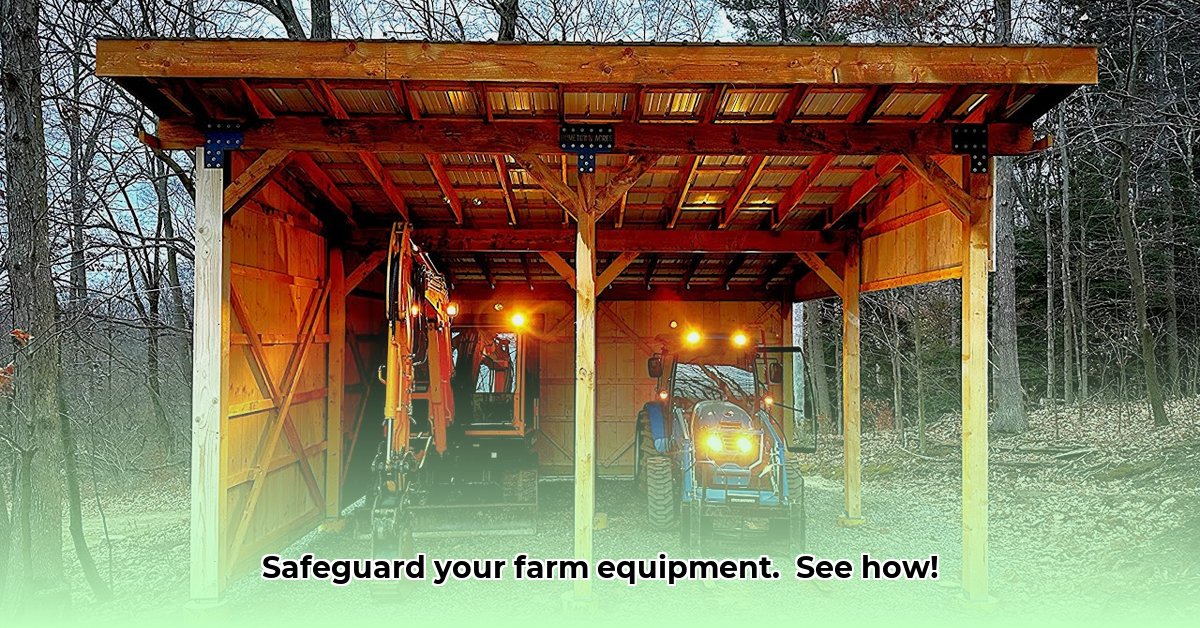
Tractor Implement Sheds: Choosing the Right Shelter for Your Needs
Protecting your valuable farm equipment is crucial for maintaining profitability and operational efficiency. A well-designed tractor implement shed safeguards your investment against harsh weather, theft, and general wear and tear. This guide provides a comparative review and actionable steps to help you choose and build the perfect shed for your farm. For more expert advice, check out this helpful resource.
Types of Tractor Implement Sheds: A Comparative Analysis
Choosing the right shed depends on your specific needs and budget. Two primary categories exist: open-sided and enclosed sheds, and the material choice (metal vs. wood) significantly impacts durability and cost.
Open-Sided vs. Enclosed:
- Open-sided sheds: Offer convenient access, ideal for frequently used equipment. However, they provide minimal protection from the elements.
- Enclosed sheds: Provide complete weather protection but necessitate more effort for equipment access. They are superior for long-term equipment preservation.
Metal vs. Wood:
- Metal sheds: Generally more affordable and durable, requiring less maintenance than wooden sheds. They offer better resistance to pests, rot, and fire. Steel, often galvanized for rust protection, is the most common and recommended material.
- Wood sheds: Allow greater design flexibility but require more maintenance and are susceptible to rot, insect damage, and fire. Their lifespan is considerably shorter than metal sheds.
Which is right for you? For most farmers, the superior durability and lower maintenance of metal sheds outweigh the limited design options. The long-term cost savings associated with metal sheds make them the preferable choice for protecting valuable farm equipment.
Material Considerations: Steel's Superiority
Steel, often galvanized (coated with zinc for rust prevention), reigns supreme for agricultural equipment sheds. Its strength, longevity, and resistance to harsh weather conditions make it a superior choice compared to other materials. While wood offers aesthetic appeal and potential for customization, its susceptibility to rot, pests, and fire makes it less suitable for long-term, reliable equipment storage.
Sizing and Design Considerations: Getting the Dimensions Right
Accurate sizing is crucial for both functionality and cost-effectiveness. A shed that's too small is impractical, while one that's too large represents wasted resources.
Step-by-Step Sizing Guide:
- Measure your largest equipment: Record the precise dimensions (length, width, height) of your largest implement.
- Add maneuvering space: Add at least three feet to each dimension to ensure easy access and movement within the shed.
- Plan for future expansion: Consider potential equipment additions and incorporate extra space accordingly.
- Check ceiling height: Ensure enough clearance for comfortable equipment access and maintenance.
Foundation and Installation: Building a Solid Base
A stable foundation is critical for a long-lasting shed. The best option depends on your budget, soil conditions, and DIY skills.
Foundation Options:
| Foundation Type | Advantages | Disadvantages | Cost | DIY Feasibility |
|---|---|---|---|---|
| Concrete | Durable, level surface, excellent stability | Expensive, requires specialized skills | High | Low |
| Gravel | Budget-friendly, easy installation | Prone to settling, less stable, poor drainage | Low | High |
| Concrete Blocks | Relatively inexpensive, level base | Requires some skill, susceptible to frost heave | Low-Medium | Moderate |
"Choosing the right foundation is paramount," says Dr. Emily Carter, Agricultural Engineering Professor at State University. "A poorly constructed foundation compromises the entire structure's integrity."
Cost Considerations: Balancing Value and Budget
Shed costs vary widely based on size, features, and supplier. While initial costs for metal sheds might appear higher than wood, their longer lifespan and reduced maintenance translate to significant long-term cost savings. Always obtain multiple quotes from reputable suppliers.
Security and Maintenance: Protecting Your Investment
Regular maintenance is key to extending your shed's lifespan. Regular inspections, prompt repairs, and strong security measures (locks, lighting) will protect your equipment and investment.
Choosing a Manufacturer/Supplier: Finding a Reliable Partner
Research potential suppliers thoroughly. Read online reviews, compare warranties, and ensure compliance with local building codes. A trustworthy supplier provides both a quality product and peace of mind.
Conclusion: Safeguarding Your Farm's Success
Investing in a durable and well-designed tractor implement shed isn't just about protecting equipment; it's about safeguarding your farm's profitability and long-term success. By following this guide, you can make an informed decision that optimizes both value and protection. Remember to prioritize a sturdy foundation, durable materials, and a reputable supplier to ensure decades of dependable service from your shed.